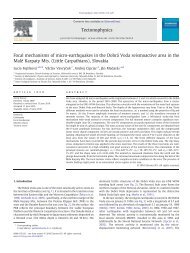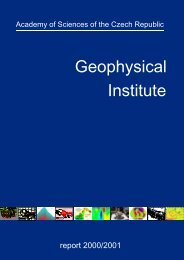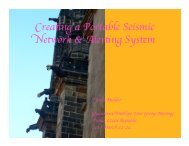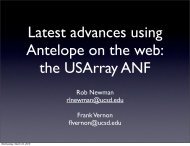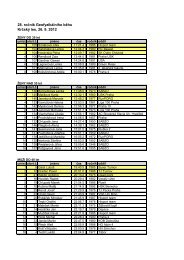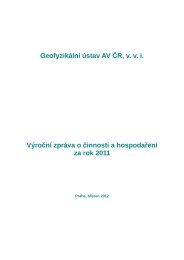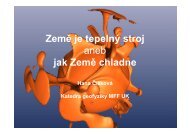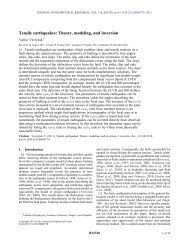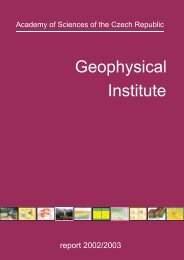Geophysical Institute of the ASCR
Geophysical Institute of the ASCR
Geophysical Institute of the ASCR
Create successful ePaper yourself
Turn your PDF publications into a flip-book with our unique Google optimized e-Paper software.
WEBNET network<br />
West Bohemia/Vogtland earthquake swarm region is among <strong>the</strong> best-monitored seismically active<br />
area in Europe. Network WEBNET, jointly operated by <strong>the</strong> <strong>Geophysical</strong> <strong>Institute</strong> (GI) and <strong>the</strong> <strong>Institute</strong><br />
<strong>of</strong> Rock Structure and Mechanics (IRSM) <strong>of</strong> <strong>the</strong> <strong>ASCR</strong> in Prague, and smaller net KRASNET,<br />
operated by <strong>the</strong> <strong>Institute</strong> <strong>of</strong> <strong>the</strong> Physics <strong>of</strong> <strong>the</strong> Earth <strong>of</strong> <strong>the</strong> Masaryk University in Brno, are located in<br />
<strong>the</strong> West Bohemia seismoactive region. Fur<strong>the</strong>r networks providing relevant, high quality data have<br />
been working in NE Bavaria and SE Saxony.<br />
At present, WEBNET is primary in <strong>the</strong> whole region. It consists <strong>of</strong> thirteen broad band threecomponent<br />
digital seismic stations consisting <strong>of</strong> <strong>the</strong> SM-3 short-period seismometers and Janus-<br />
Trident/Nanometrics acquisition systems, and covering an area <strong>of</strong> about 900 km2. Its configuration<br />
and <strong>the</strong> parameters <strong>of</strong> <strong>the</strong> seismograph systems guarantee high-quality recording <strong>of</strong> West<br />
Bohemia/Vogtland events <strong>of</strong> magnitudes -0.5 ≤ ML ≤ 5 in a frequency range <strong>of</strong> 0.5 to 80 Hz with<br />
sampling frequency <strong>of</strong> 250 Hz. Thus, WEBNET makes possible to record high-frequency waves<br />
generated by local events, short-period body waves <strong>of</strong> regional and distant earthquakes, and surface<br />
waves excited by quarry blasts fired in <strong>the</strong> neighbourhood <strong>of</strong> <strong>the</strong> region under study.<br />
Data from all <strong>the</strong> stations are transmitted via Internet to GI, Prague. Besides, a three-component very<br />
broadband (VBB) system providing continuous digital records <strong>of</strong> seismic signals with periods up to<br />
120 seconds has been operating at stations NKC (in <strong>the</strong> centre <strong>of</strong> <strong>the</strong> NK zone) and LAC (sou<strong>the</strong>rn<br />
part <strong>of</strong> <strong>the</strong> seismoactive region). To provide <strong>the</strong> best possible area and azimuth coverage with respect<br />
to <strong>the</strong> individual focal zones, ten seismic vaults consisting <strong>of</strong> a container with a concrete pillar about<br />
2 m below <strong>the</strong> surface were built in <strong>the</strong> West Bohemia for deploying mobile stations in <strong>the</strong> case <strong>of</strong><br />
enhanced seismic activity. The seismograms <strong>of</strong> all tectonic events (about 25000), recorded by <strong>the</strong><br />
WEBNET net and <strong>the</strong> VBB stations since, respectively, 1992 and 1998 are archived in a digital<br />
database. Data from o<strong>the</strong>r nets operating in <strong>the</strong> region are available on request.<br />
The geo<strong>the</strong>rmal climate-change observatories<br />
The geo<strong>the</strong>rmal climate-change observatories on <strong>the</strong> grounds <strong>of</strong> <strong>the</strong> <strong>Geophysical</strong> <strong>Institute</strong> at Spořilov,<br />
at <strong>the</strong> meteorological station Kocelovice (operated by <strong>the</strong> Czech Hydrometeorological <strong>Institute</strong>) and<br />
near Potůčky (Krušné Hory Mountains) were established in <strong>the</strong> years 1993, 1998 and 2002,<br />
respectively. The observatories monitor air (in <strong>the</strong> heights <strong>of</strong> 2 m and 5 cm above <strong>the</strong> surface), soil<br />
(2, 5, 10, 20, 50 and 100 cm below <strong>the</strong> surface) and bedrock temperatures (down to <strong>the</strong> depth <strong>of</strong> 40 m)<br />
at a sampling rate <strong>of</strong> 30 minutes with <strong>the</strong> aim to provide data on <strong>the</strong> air-ground temperature coupling<br />
and on a propagation <strong>of</strong> seasonal, interannual and secular surface temperature changes into <strong>the</strong><br />
bedrock. The monitoring is expected to continue for at least several years to map <strong>the</strong> tracking <strong>of</strong> <strong>the</strong><br />
air and ground mean annual temperatures on an interannual time scale. The tracking is crucial for <strong>the</strong><br />
proper climatic interpretation <strong>of</strong> <strong>the</strong> ground surface temperature history reconstructed from borehole<br />
temperature pr<strong>of</strong>iles.<br />
Geographic co-ordinates <strong>of</strong> <strong>the</strong> geo<strong>the</strong>rmal observatories<br />
Code Latitude Longitude Altitude<br />
Spořilov 50.040 14.478 275<br />
Kocelovice 49.467 13.839 518<br />
Potůčky 50.434 12.778 864<br />
11




